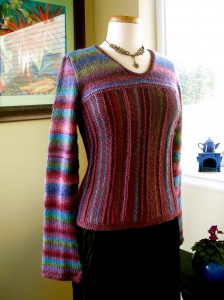
My Iris Color Way Hank Knit Sweater
I have just finished knitting this beautiful blue, purple and green striped sweater from the pattern for the Poppy sweater in the book Yarnplay by Lisa Shobana Mason. Poppy was originally done in reds and browns using Noro yarns Silk Garden and Cash Iroha. I substituted Tonalita for the striped sleeves and the striped portion of the yoke and body and an old unlabeled purple mystery yarn in a silk and wool blend for the solid red sections in the original pattern. The mystery yarn was given to me by a friend and I had it for years without any tags or labels so I have no idea what it is. I do know it is an old yarn and isn’t carried by yarn stores now as I have taken it around to several with me and no one recognizes it. I luckily had just enough for this project!
I am calling this my Iris sweater, because it is done in blue and purple iris colors, not red poppy colors. They are both named after flowers though, which was one of my attractions to the design ~ being Lady Violette and having an interest in all things floral!
The original pattern was knit of scratchy yarns and I chose to do mine out of very soft yarns. I cannot wear rough yarns. They are way too itchy for me, even during the knitting process. I did use yarns that worked up at the same gauge. I had to adjust the pattern to fit me and measure and make adjustments constantly as I was working. It was a difficult project. I only recommend undertaking it if you are an advanced knitter and have a great deal of patience to see it through to finishing. I had to stop and work on other projects that were not so demanding, then pick it up again and continue several times before I finished it. It is beautiful now that it is finally done so I guess it was worth it!

Fashionably Long Hand Covering Sleeves in Tonalita Knit In the Round on Five Douple Pointed Needles
The sleeves may appear long in the pictures. That is because they are designed to be the trendy long type of sleeve that goes over the palm of the hand. They are also taken up when worn so they really do fit perfectly. The bottom edges of the sleeves cover my hands and reach the bases of my fingers exactly. This is very pretty and very cozy ~ but definitely makes for a dressy sweater rather than one you would wear for cooking or doing the dishes! ( A great excuse for avoiding those activities!)
The bottom part of the sweater is knit in a strip from side to side in stockinette stitch with occasional stripes in garter stitch and stockinette stitch. The knitter adds these whenever and wherever she likes, so each rendition of this pattern is unique. I put in a lot more stripes than the original designer did ~ originally to be sure I would have enough of the solid purple color to finish the body ~ ultimately because I really liked the design better that way!
I knit the sleeves in the round on double pointed needles in order to avoid seams. I made the stripes on both sides match each other as well ~ on the yoke and both sleeves. This required cutting the yarn and reattaching it and carefully keeping track of the rows worked in each color. I did the back yoke on mine with a lot more texture and garter stitch worked into it than the designer used in hers as well. I tried to do the same method in the front but it didn’t work out as well there! So my yoke ended up being highly textured in the back and smooth stockinette stripes on the front. this was risky, but it worked.

The Back of the Iris Sweater Featuring Garter Stitch Stripes in Two Directions
All in all this sweater was a huge experiment. I added a double row of garter stitch around the bottom to tie it in better with the edging around the neck. The designer originally finished off her edges with a line of single chain crochet! Because I used different yarns and am a different knitter, my Iris sweater almost looks like a different sweater than the original Poppy design. This often happens when you knit something in very different yarns and make fitting and design adjustments along the way.
My Iris Sweater is an interesting project that evolved using bits and pieces of leftovers from two other projects. And using a lot of determination! It is sometimes fun to see what you can do working with limitations. In this case only having small amounts of two types of yarn that weren’t even the ones called for in the pattern. If I had gotten stuck without enough to finish I would probably have added yet another yarn or changed the design to accommodate my limitations.
I was anxious to photograph it and post it. After the agony of finishing it I am anxious to get some feedback from other knitters and designers! Of course I am interested in the opinions of non knitters as well. I photographed it with a black pleated skirt, but, for a more casual look I plan to wear it with dark green or dark blue vintage jeans and dark green boots or a dark purple skirt and purple tights that I have.
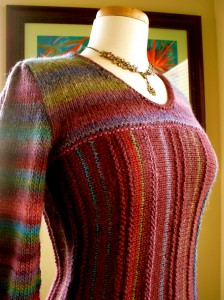
Corset~Like Figure Forming Fit
I knit my Iris sweater to be very fitted with a slight negative ease. To me the body of the sweater has a corset~like effect with the shape of the body and the slimming vertical stripes simulating the stays of a corset. This is form fitting and figure flattering. The yarn is fairly fine in quality and certainly in feel, so I wanted a refined looking fitted sweater rather than a loose fitting one. It is possible to make fitted knits when you make them custom to fit yourself or another person for whom you are knitting. The trick to achieving that is negative ease. I made the sweater tighter than the designer did hers. I achieved a dressier more formal look. Her looser fitting one is more casual.
Knitting is an art form, and in making art, each artist’s interpretation is individual and unique, even when using a pattern. In knitting I find a pattern is really just a guide to get me started. I rarely make any pattern the exact way it is written with the same materials the writer used. In fact I do not know if I ever have.
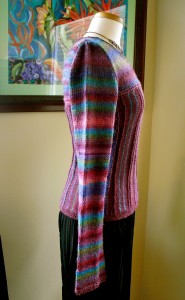
Side View of beautifully Shaped Iris Sweater
I always wonder if people who do not knit have any idea how complicated making something like this sweater is. Think about it! Every single stitch is made by hand and has to be counted and kept track of while you go! It requires a tremendous amount of concentration and time and self discipline. Hand knitting takes a lot more time than sewing.
It breaks my heart when I see a beautiful hand knit sweater that someone lovingly made somebody given to a thrift store. I have found them and It is my personal mission to rescue them whenever I do. It is on the same level as rescuing an abandoned animal for me! Knitting is an art form and to do it well is an amazing accomplishment. It takes hundreds of hours to make a hand knitted garment. I will be pleased if people who didn’t understand anything about what was involved in knitting before reading my blog develop an interest in it from reading what I write and looking at the pictures I post. Not only does the knitting take a lot of time and expertise, but the yarns and fibers themselves are amazing, fascinating and very valuable. I will write more about that in the future.
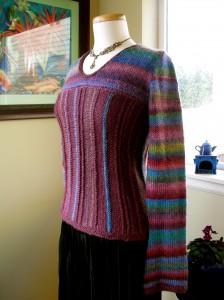
Fitted Knit ~ Like a Corset Through the Torso
The Original Poppy Pattern, in red yarns is pictured below. More photos in red can be seen on the blog of Lisa Shobhana Mason and can be found in her book Yarnplay, available from Amazon. This sweater is photographed on the cover of her book and directions begin on page 98. It is rated advanced level for experienced knitters. I would definitely agree with that rating! You can find photos of other knitters completed versions of this pattern on Ravelry if you would like to see how their interpretations of the same original pattern turned out. I always enjoy seeing them! You can see them on Ravelry (requires free account). I just looked at these other knitters works – and what fun it was to see how they differed from mine! This is always the case with the feminine arts like quilting, knitting, sewing, crocheting, embroidery, etc. – each woman’s personality comes out in her needlework. Check it out, you will see what I mean! The sweater has been made up in many different yarns, colors and sizes.
Incidentally Ravelry is a great place to get ideas and find patterns for knitting and see other peoples work.
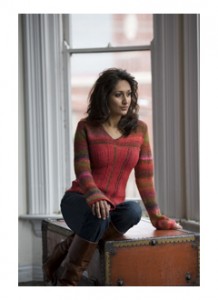
Original Poppy Sweater in Red by Lisa Shobhana Mason
If you want to make a fitted garment with negative ease experiment with the following suggestions. Knit a size smaller than you normally would. Be sure to make the pattern pieces long enough though! You will want them to end up tighter around but not a lot shorter! Try knitting on a size smaller needles than the pattern calls for. This will create a tighter knit, thus smaller, piece of knitting. Be sure, again, that the length is adequate. In this case I experimented and ended up using one size smaller needles than originally called for in the pattern and adding length by knitting a few extra rows to get the length I needed through the torso. I knit sections, take them off the needles and try them out by holding them up to my body or that of the person I am knitting for. I put them back on the needles and make any necessary adjustments, then continue. I sometimes have to take out fairly large sections and redo them, but I do it because I want perfect results. The trick to avoiding having to redo large sections is to try things on to test the size and figure out the measurements fairly often. theoretically you should be able to do this by calculating it out on paper, but that is not the same thing as a try on! The only true test is actual fitting on the body of the person for whom you are making the garment. It is always worth the extra time it takes.

















